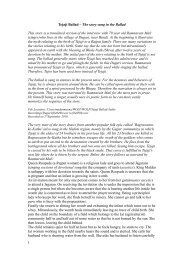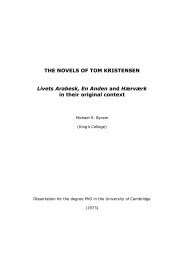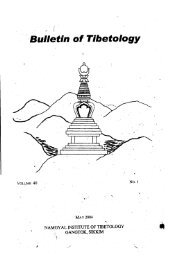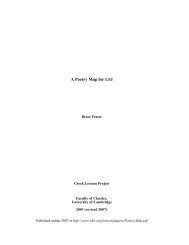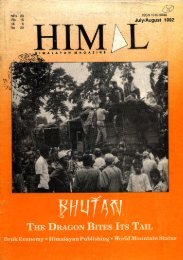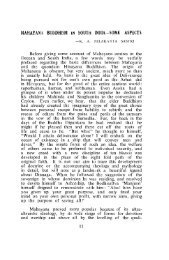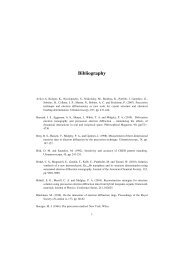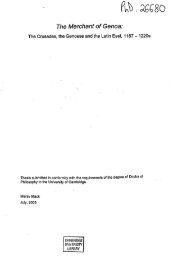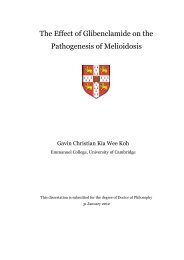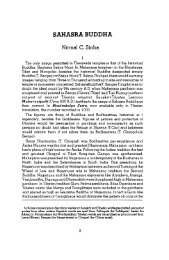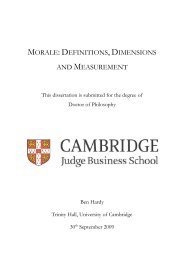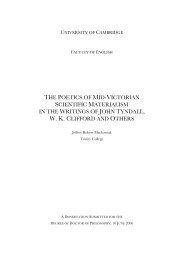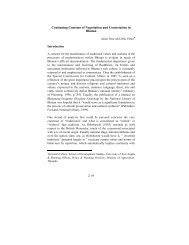Citing the spoken word: Adventures in language documentation
Citing the spoken word: Adventures in language documentation
Citing the spoken word: Adventures in language documentation
Create successful ePaper yourself
Turn your PDF publications into a flip-book with our unique Google optimized e-Paper software.
<strong>Cit<strong>in</strong>g</strong> <strong>the</strong> <strong>spoken</strong> <strong>word</strong>: <strong>Adventures</strong> <strong>in</strong><br />
<strong>language</strong> <strong>documentation</strong><br />
Nicholas Thieberger<br />
School of Languages and L<strong>in</strong>guistics<br />
The University of Melbourne<br />
Department of L<strong>in</strong>guistics<br />
University of Hawai'i at Mānoa
Me, selwan ag kupi emãe, tiawi itraus traus<br />
traus traus, natrauswen ga itaos nlag. Itrausi<br />
pan kaipa. Me komam uta laap k<strong>in</strong> uto mau, a?<br />
Malen umat, <strong>in</strong>om.<br />
But when you are far away <strong>the</strong> old man can talk<br />
and talk and talk, his story is like <strong>the</strong> w<strong>in</strong>d.<br />
He tells it and it is gone. But <strong>the</strong>re aren't<br />
many of us left. When we die, it will be<br />
f<strong>in</strong>ished.<br />
†Kalfapũn Mailei, 1998, Erakor Village, Efate, Vanuatu<br />
(NT1-98009-A, 1932.36 1942.16)
“Il n’est pas d’avantage possible à la<br />
l<strong>in</strong>guistique de représenter fidèlement<br />
le parler des langues vivantes même à<br />
l’aide de ces transcriptions arbitraires,<br />
tout à fait <strong>in</strong>suffisantes, imag<strong>in</strong>ées faute<br />
de mieux, et qu’aucun accord n’est<br />
parvenu à uniformiser. ... tout celà dont<br />
la l<strong>in</strong>guistique est <strong>in</strong>capable, le<br />
phonographe dès ma<strong>in</strong>tenant en offre<br />
la possibilité.”<br />
“Nor is it possible for l<strong>in</strong>guistics to faithfully represent <strong>the</strong> speech of liv<strong>in</strong>g<br />
<strong>language</strong>s even with <strong>the</strong> help of its arbitrary and totally <strong>in</strong>sufficient<br />
transcriptions, made up for want of better and which no agreement has ever<br />
made uniform. ... all that of which l<strong>in</strong>guistics is <strong>in</strong>capable, <strong>the</strong> phonograph from<br />
now on makes possible.”<br />
(Léon Azoulay 1900:175)<br />
Azoulay, Léon 1900. L’ère nouvelle des sons et des bruits: Musées et archives phonographiques. Bullet<strong>in</strong>s et<br />
Memoires de la Societé d’Anthropologie de Paris 1, 3 mai 1900, 172–8.
‘ <strong>the</strong>re is <strong>the</strong> special methodological <strong>in</strong>terest <strong>in</strong><br />
<strong>the</strong> frank and full presentation of all available<br />
l<strong>in</strong>guistic evidence ’ (Mal<strong>in</strong>owski 1935: 4)
‘If I could, by a good phonographic record, counterfeit <strong>the</strong><br />
liv<strong>in</strong>g voice of Tokulubakiki: […] I should certa<strong>in</strong>ly be<br />
better able to translate <strong>the</strong> text <strong>in</strong> <strong>the</strong> sense of<br />
impart<strong>in</strong>g to it its full cultural flavour and significance.<br />
Aga<strong>in</strong>, if by c<strong>in</strong>ematographic picture I could reproduce<br />
<strong>the</strong> facial expression, <strong>the</strong> bodily attitude, <strong>the</strong> significant<br />
gestures, this would add ano<strong>the</strong>r contextual<br />
dimension.’ (Mal<strong>in</strong>owski 1935: 26)
“I'm not particularly <strong>in</strong>terested <strong>in</strong> 'smoo<strong>the</strong>d-over' versions of native culture.<br />
I like <strong>the</strong> stuff <strong>in</strong> <strong>the</strong> raw, as felt and dictated by <strong>the</strong> natives. [...] The<br />
genu<strong>in</strong>e, difficult, confus<strong>in</strong>g, primary sources. These must be presented,<br />
whatever else is done. […] There are too many glib monographs, most<br />
of which time will show to be highly subjective performances. We need<br />
to develop <strong>in</strong> cultural anthropology that anxious respect for documentary<br />
evidence that is so familiar to <strong>the</strong> historian, <strong>the</strong> classical scholar, <strong>the</strong><br />
Orientalist. […] where is <strong>the</strong> raw evidence? I can't tell whe<strong>the</strong>r a given<br />
statement is common native knowledge or is merely your <strong>in</strong>terpretation<br />
of one man's say-so.”<br />
Letter written by Edward Sapir to Fay Cooper-Cole, 25 April 1938, quoted <strong>in</strong> Regna Darnell.<br />
1990. Edward Sapir: L<strong>in</strong>guist, Anthropologist, Humanist. Berkeley: University of California<br />
Press.
‘There is no reason whatever why, <strong>in</strong> <strong>the</strong><br />
future, an exact and physiological study of<br />
speech should not use <strong>the</strong> apparatus of<br />
sound films for reproduc<strong>in</strong>g fully<br />
contextualised utterances.’ (Mal<strong>in</strong>owski 1935: 26)<br />
Mal<strong>in</strong>owski, Bronislaw. 1935. Coral gardens and <strong>the</strong>ir magic. Vol II<br />
London: G. Allen & Unw<strong>in</strong>.
Descriptive grammars written s<strong>in</strong>ce Sapir and<br />
Mal<strong>in</strong>owski may have been built on a corpus<br />
of record<strong>in</strong>gs,<br />
but that is not evident from <strong>the</strong> f<strong>in</strong>ished product
Perspectives on grammar writ<strong>in</strong>g<br />
Payne: ‘good l<strong>in</strong>guistic descriptions provide <strong>the</strong><br />
raw data for much research <strong>in</strong>to <strong>the</strong><br />
organization of <strong>the</strong> human m<strong>in</strong>d’<br />
In recent years <strong>the</strong> ‘emphasis has shifted back<br />
to <strong>the</strong> centrality of data.’<br />
Studies <strong>in</strong> Language, 2006, 30:2 p.236
First version: 1990
Fieldwork <strong>in</strong> Eratap and<br />
Erakor villages, Vanuatu<br />
1996–<br />
Grammar based <strong>in</strong> a corpus<br />
Examples cited to orig<strong>in</strong>al<br />
sources<br />
All material archived
Fieldwork <strong>in</strong> Eratap and<br />
Erakor villages, Vanuatu<br />
1996–<br />
Grammar based <strong>in</strong> a corpus<br />
Examples cited to orig<strong>in</strong>al<br />
sources<br />
All material archived
How to create a citable set of<br />
textual material l<strong>in</strong>ked to<br />
primary media?
Time-aligned Transcription transcripts with timealignment<br />
Transcriber: http://sourceforge.net/projects/trans/<br />
Elan: http://www.mpi.nl/tools/elan.html<br />
Transana, Exmaralda, Anvil …
Audiamus<br />
Created for <strong>in</strong>teract<strong>in</strong>g with field record<strong>in</strong>gs via <strong>the</strong>ir transcripts<br />
Version 1 – HyperCard – 1999,<br />
Version 2 – RunTime Revolution 2002<br />
http://bit.ly/audiamus
Audiamus<br />
Analysis of a l<strong>in</strong>guistic media corpus via text<br />
Build<strong>in</strong>g a citable corpus of media via l<strong>in</strong>ked transcripts<br />
A work<strong>in</strong>g tool (now) that gives access to a media<br />
corpus via a time-aligned textual <strong>in</strong>dex<br />
Takes <strong>the</strong> output of Transcriber or Elan as <strong>in</strong>put<br />
Built <strong>in</strong> proprietary software, Runtime Revolution (rapid<br />
prototyp<strong>in</strong>g)<br />
W<strong>in</strong>/Mac (&L<strong>in</strong>ux) standalone versions<br />
http://bit.ly/audiamus
Audiamus workflow<br />
Audiamus<br />
Shoebox / Toolbox Quicktime<br />
XML Tab-delimited text<br />
Media file<br />
.wav, .mp3,<br />
.mov, .mpeg, etc.<br />
Transcribed and l<strong>in</strong>ked<br />
(Transcriber, Elan)
Audiamus<br />
Ability to cite primary data<br />
(NT1-98003-B, 539.887, 548.86)
Import<br />
Tab-delimited text<br />
Limsi label (Transcriber)<br />
Export<br />
Tab-delimited text<br />
XML<br />
Toolbox<br />
Quicktime<br />
Audiamus
Outputs from Audiamus<br />
Toolbox !<br />
\_sh v3.0 498 SE Text<br />
\aud 98009b 22.94 28.64<br />
\tx (T) A, kagaag traus nmatu iskei,<br />
\aud 98009b 29.16 37.82<br />
\tx go nanwei iskei, rato. Me ratik ki tesa.<br />
\aud 98009b 37.96 47.06<br />
\tx Me ipiatlak teesa iskei ipaakor faat elau.
Outputs from Audiamus<br />
Quicktime<br />
{QTtext}{font:Geneva}{pla<strong>in</strong>}{size:12}{textColor: 65535, 65535, 65535}{backColor:<br />
0, 0, 0}{justify:center}{timeScale:1000}{width:160}{height:48}{timeStamps:absolute}<br />
{<strong>language</strong>:0}{textEncod<strong>in</strong>g:0}<br />
[00:00:00.]<br />
{SPEAKER = HT}Ipiatlak nmatu iskei,<br />
[00:00:02.920]<br />
nmatu tiawi iskei ipiatlak tesa <strong>in</strong>ru rana rato panpan. [….]<br />
[00:00:08.120]
Benefits of Audiamus<br />
Local control of data<br />
Immediate access (no web connection)<br />
Ability to <strong>in</strong>teract with and improve <strong>the</strong> transcript<br />
Ability to 'clip' citation forms<br />
Imports and exports several formats<br />
F<strong>in</strong>d and concordance function<br />
Creation of ‘playlists’ organised by <strong>the</strong>me ra<strong>the</strong>r<br />
than by media<br />
Freely distributed under GNU General Public<br />
License
Problems of Audiamus<br />
Data has to be imported, ideally it would be <strong>in</strong><br />
XML and read by an Audiamus-like browser<br />
Audiamus implies a workflow and so version<br />
control is a problem<br />
Proprietary software means development can<br />
only be done by buy<strong>in</strong>g Runtime Revolution
Typical workflow result<strong>in</strong>g <strong>in</strong> well-formed data<br />
W<br />
or<br />
kfl<br />
o<br />
w<br />
Record<strong>in</strong>g<br />
- named<br />
analogue digitised/<br />
digital captured<br />
descriptive metadata added<br />
concordance of texts, navigation tool<br />
Media corpus <strong>in</strong>stantiates l<strong>in</strong>ks to media<br />
(e.g. Audiamus)<br />
output to e.g. Toolbox for<br />
<strong>in</strong>terl<strong>in</strong>earis<strong>in</strong>g<br />
Texts, dictionary etc<br />
archival digital file<br />
archived<br />
transcribed and<br />
l<strong>in</strong>ked (us<strong>in</strong>g e.g.<br />
Transcriber<br />
or Elan)<br />
archived
Citability<br />
Citation of <strong>the</strong> <strong>spoken</strong> <strong>word</strong> requires a<br />
persistent form of <strong>the</strong> cited form<br />
Persistence of name and location is provided<br />
by a digital archive
How will WOLP ma<strong>in</strong>ta<strong>in</strong> persistent<br />
identification of texts?<br />
How will WOLP license <strong>the</strong> use of texts?
DOI? Handle.net?<br />
Catalog<strong>in</strong>g texts<br />
What repository to use?<br />
Example of PARADISEC
Onl<strong>in</strong>e catalogue: paradisec.org.au/catalog
Onl<strong>in</strong>e catalogue: paradisec.org.au/catalog<br />
33
Open Archives Initiative
Open Language Archives Community (OLAC)<br />
http://www.<strong>language</strong>-archives.org/<strong>language</strong>/erk
Data access (paradisec.org.au/repository)<br />
36
Data access (paradisec.org.au/repository)
Record<strong>in</strong>g >Transcript<br />
Preg nafkal skot nam̃er nig Emlakul.<br />
NT1-98002-A 316.43 320.317<br />
Reuse
\id 061:005<br />
\aud NT1-98002-A 316.43 320.317<br />
\tx Preg nafkal skot nam̃er nig Emlakul.<br />
\mr preg nafkal skot nam̃er nig Emlakul<br />
\mg make war with people of p.name<br />
\fg Fight with <strong>the</strong> people from Malakula.<br />
Reuse<br />
Record<strong>in</strong>g >Transcript > Interl<strong>in</strong>ear
Preg nafkal skot nam̃er nig Emlakul. Fight with <strong>the</strong> people from Malakula.<br />
Onl<strong>in</strong>e dictionary with sound and image l<strong>in</strong>ks, constructed from<br />
well-formed underly<strong>in</strong>g data
Me, selwan ag kupi emãe, tiawi itraus traus<br />
traus traus, natrauswen ga itaos nlag. Itrausi<br />
pan kaipa. Me komam uta laap k<strong>in</strong> uto mau, a?<br />
Malen umat, <strong>in</strong>om.<br />
But when you are far away <strong>the</strong> old man can talk<br />
and talk and talk, his story is like <strong>the</strong> w<strong>in</strong>d.<br />
He tells it and it is gone. But <strong>the</strong>re aren't<br />
many of us left. When we die, it will be<br />
f<strong>in</strong>ished.<br />
†Kalfapũn Mailei, 1998, Erakor Village, Efate, Vanuatu<br />
(NT1-98009-A, 1920.92, 1930.76)<br />
NT1‐98009‐A.wav 1932.36 1942.16
ITunes <strong>in</strong>stallation<br />
Erakor school, Efate, Vanuatu
Example of reuse of <strong>in</strong>terl<strong>in</strong>ear<br />
glossed text (IGT)<br />
Ipitlak nmatu <strong>in</strong>ru, rato elag Epũf.<br />
i= pitlak nmatu i= nru ra= to elag Epũf<br />
3sRS= have woman 3sRS= two 3d.exRS= stay above p.name<br />
There are two women, <strong>the</strong>y lived up at Bufa.<br />
NT1-98004-A 210.34, 212.2
Interl<strong>in</strong>earis<strong>in</strong>g tools<br />
TRANSC(ript) for CPM<br />
IT for DOS and Mac<strong>in</strong>tosh <strong>in</strong> <strong>the</strong> 1980s<br />
Shoebox and its successor Toolbox<br />
ITE (Jacobson n.d.)<br />
Fieldworks<br />
TypeCraft<br />
For a detailed list<strong>in</strong>g of annotation tools see:<br />
http://annotation.exmaralda.org/<strong>in</strong>dex.php/L<strong>in</strong>guistic_ Annotation
http://lacito.vjf.cnrs.fr/archivage/<strong>in</strong>dex.htm
http://lacito.vjf.cnrs.fr/archivage/tools/show_text.php?id=crdo-LAG_FER_SOUND
AILLA text / media formats<br />
http://www.ailla.utexas.org/search/resource.html?r_id=157
http://www.<strong>in</strong>digitube.com.au/
Why not use youtube?<br />
Text / media l<strong>in</strong>k not provided for<br />
No commitment to longevity<br />
No path from l<strong>in</strong>guistic fieldwork tools<br />
(especially <strong>in</strong>terl<strong>in</strong>ear glossed text)<br />
Lack of control<br />
• Ideally l<strong>in</strong>guistic <strong>in</strong>stitutions would be curators<br />
• IP issues not <strong>in</strong> control of <strong>the</strong> depositor
http://eopas.erc.unimelb.edu.au:8080/exist/eopas3/browse.xq<br />
Text and media
http://eopas.erc.unimelb.edu.au:8080/exist/eopas3/browse.xq<br />
Text and media
http://eopas.erc.unimelb.edu.au:8080/exist/eopas3/browse.xq<br />
Text and media
amur<strong>in</strong><br />
<br />
<br />
a=<br />
1sgRS=<br />
<br />
<br />
mur<br />
want<br />
<br />
<br />
-i<br />
-TS<br />
<br />
<br />
-n<br />
-3sgO<br />
<br />
<br />
Fragment of IGT encoded <strong>in</strong> XML
We need a standard schema for<br />
IGT<br />
No schema (standard representation) for IGT<br />
So ODIN relies on heuristics to locate IGT on <strong>the</strong> web<br />
(as <strong>the</strong> basis for mak<strong>in</strong>g typological claims)<br />
http://www.csufresno.edu/od<strong>in</strong>/<br />
Inferr<strong>in</strong>g <strong>the</strong> nature of IGT from contextual clues
Eopas sample converted from Toolbox XML<br />
<br />
<br />
105<br />
<br />
001<br />
200518.aud 20.507 27.202<br />
<br />
Amur<strong>in</strong><br />
a=<br />
1sgRS=<br />
mur<br />
want<br />
-i<br />
-TS<br />
-n<br />
-3sgO<br />
<br />
I want to tell you a story.<br />
<br />
<br />
<br />
<br />
I want to tell you a story<br />
Amur<strong>in</strong> na kagag<br />
<br />
<br />
amur<strong>in</strong><br />
<br />
<br />
a=<br />
1sgRS=<br />
<br />
<br />
mur<br />
want<br />
<br />
<br />
-i<br />
-TS<br />
<br />
<br />
-n<br />
-3sgO<br />
<br />
<br />
<br />
….
Upload<strong>in</strong>g…<br />
http://eopas.esrc.unimelb.edu.au:8080/exist/eopas3/transcript/15582013
Brows<strong>in</strong>g…
View<strong>in</strong>g and concordanc<strong>in</strong>g…
EOPAS - http://bit.ly/eopas2010<br />
• log<strong>in</strong> functionality: au<strong>the</strong>nticated access to upload/edit/download<br />
• upload functionality of video/audio<br />
• transcod<strong>in</strong>g video/audio to Ogg Vorbis and Ogg Theora formats for delivery<br />
• storage of video/audio<br />
• download video/audio<br />
• upload functionality of text (ELAN, Transcriber, IGT from Toolbox)<br />
• handl<strong>in</strong>g of unicode and o<strong>the</strong>r i18n characters<br />
• validation of text<br />
• transcod<strong>in</strong>g text<br />
• storage of text<br />
• download text <strong>in</strong> different formats (ELAN, pdf, rtf)<br />
• aligned display of text with video/audio<br />
• search<br />
• citability on <strong>the</strong> level of syllables l<strong>in</strong>ked to video/audio<br />
• edit<strong>in</strong>g (but not author<strong>in</strong>g!) of text<br />
• open source publication of system<br />
• creation of project <strong>in</strong> Sourceforge
<br />
<br />
<br />
<br />
Amur<strong>in</strong> gag<br />
puserek, Nick, kafo gag pusereki kusu go wit. I want to tell you,<br />
Nick, I'll tell you about <strong>the</strong> rat and <strong>the</strong> octopus. <br />
<br />
Confluence<br />
Several projects are now aim<strong>in</strong>g to produce<br />
textual material <strong>in</strong> small <strong>language</strong>s, e.g.,<br />
WOLP & Firebird<br />
PARADISEC<br />
AILLA<br />
Potentially each archive and fund<strong>in</strong>g project will<br />
need to present texts and media
Central service harvest<strong>in</strong>g text collections for search and display<br />
67
Conclusion<br />
Need for standards for encod<strong>in</strong>g textual<br />
material as <strong>in</strong>terl<strong>in</strong>ear text l<strong>in</strong>ked to media<br />
Ideally build<strong>in</strong>g <strong>the</strong>se standards <strong>in</strong>to a<br />
normal l<strong>in</strong>guistic workflow<br />
Creat<strong>in</strong>g multiple outputs from a s<strong>in</strong>gle<br />
research effort<br />
Excit<strong>in</strong>g possibilities for return of material<br />
and for representation of small <strong>language</strong>s
How do we catch <strong>the</strong> w<strong>in</strong>d?<br />
Me, selwan ag kupi emãe, tiawi itraus traus traus traus, natrauswen ga<br />
itaos nlag. Itrausi pan kaipa. Me komam uta laap k<strong>in</strong> uto mau, a? Malen<br />
umat, <strong>in</strong>om.<br />
But when you are far away <strong>the</strong> old man can talk and talk and talk, his<br />
story is like <strong>the</strong> w<strong>in</strong>d. He tells it and it is gone. But <strong>the</strong>re aren't<br />
many of us left. When we die, it will be f<strong>in</strong>ished.<br />
†Kalfapũn Mailei, 1998, Erakor Village, Efate, Vanuatu



